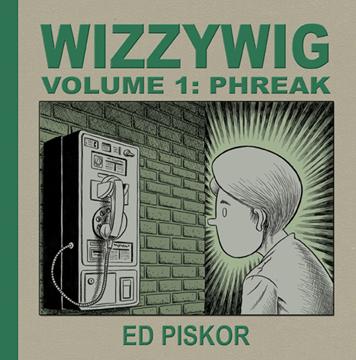
| #43 | 2/13/08 | #6 |
Greetings Faithful Talkbackers, Ambush Bug here, welcoming you to another installment of AICN Comics. Before we get started with the reviews, I want to remind everyone to check back in on Fridays for our new/old AICN Comics News column aptly dubbed SHOOT THE MESSENGER (You can check out last Friday’s column here). My good friend and fellow @$$Hole Stones Throw is the man putting himself in the line of fire to bring you all the previous week’s pertinent news bits, Q & @ interviews, and of course, a heaping helping of sweet @$$y goodness. This week look for an interview with THE PERRY BIBLE FELLOWSHIP’s Nicholas Gurewitch.
And it’s Oscar time, so you all know what that means. It means that it’s also time for comic bookdom’s finest hour, THE @$$IE AWARDS! Look for an abundance of @$$IES to be handed out next Wednesday!
In the meantime, we have a scad of reviews for you. And here they are…
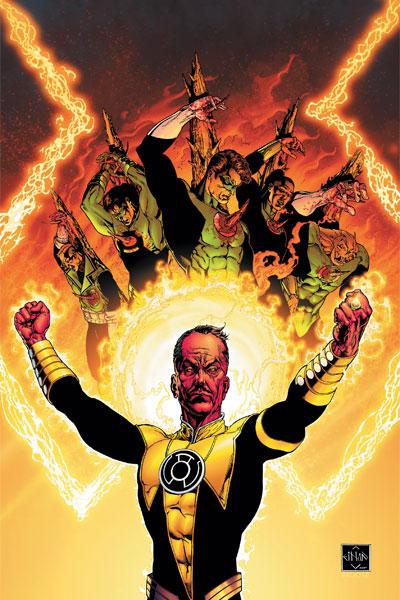
THE SINESTRO CORPS WAR & TALES OF THE SINESTRO CORPS
Writers: Johns, Gibbons, Marz, Burnett, Gates, Tomasi Art: Gibbons, Van Sciver, Reis, Gleason, Unzueta, Melo, Blaine, Alixe, Nguyen, Woods, Ordway, Igle, Lacombe Publisher: DC Comics Reviewer: barking_frog
This review covers:GREEN LANTERN #18 - 20 backups “Tales of the Sinestro Corps” GREEN LANTERN SINESTRO CORPS SPECIAL GREEN LANTERN #21 - 26 GREEN LANTERN CORPS #14 – 19 TALES OF THE SINESTRO CORPS: PARALLAX TALES OF THE SINESTRO CORPS: CYBORG SUPERMAN TALES OF THE SINESTRO CORPS: SUPERMAN-PRIME TALES OF THE GREEN LANTERN CORPS: ION BLUE BEETLE #20 GREEN LANTERN/SINESTRO CORPS: SECRET FILES AND ORIGINS
The TPB's are scheduled to be released: Green Lantern: The Sinestro Corps War, Vol. 1, Feb 20, 2008 Green Lantern: The Sinestro Corps War, Vol. 2, Jun 3, 2008 Green Lantern: Tales of the Sinestro Corps, Jun 3, 2008
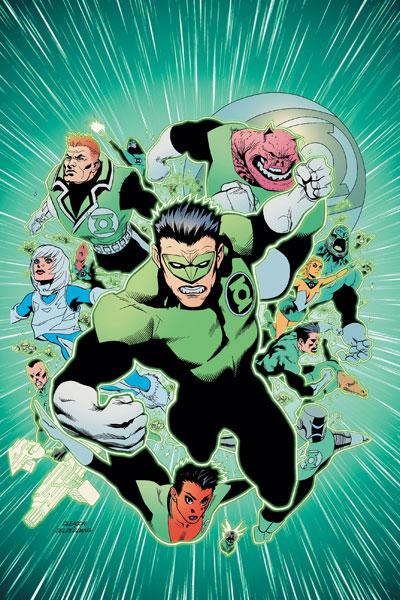 This was a difficult review for me to write; I'm coming at THE SINESTRO CORPS WAR with almost zero knowledge of the "GL universe," and not all that much knowledge about the DCU in general (I was a Marvel zombie, and haven't yet completely corrected for that condition).
This was a difficult review for me to write; I'm coming at THE SINESTRO CORPS WAR with almost zero knowledge of the "GL universe," and not all that much knowledge about the DCU in general (I was a Marvel zombie, and haven't yet completely corrected for that condition).I often start to rough out a review before I've finished reading the material, so I'm used to throwing pages away as a story defeats my early impressions. But nothing has punished me in this regard the way SINESTRO WAR has. Every time I thought I was seeing a problem with it, one or two issues later the problem would be addressed. SINESTRO WAR is big, in a number of ways -- it's a successful blend of many elements, and it forced me to change my mind about it over and over.
This is a long review, so for those considering buying the trades but who don't care about my rambles, here's what I say in summary:
If you know GL and general DCU history, you will probably love SINESTRO WAR. It's a great story.
If you don't know GL/DCU history, the first half of SINESTRO WAR could be work for you -- but it pays the effort back in its last half. That might make it a poor choice for a casual comics reader, and definitely makes it a poor choice for someone looking for an easy jumping-on point. But by the same token, if the reader is willing to work through the first half without much idea what's going on, ultimately I doubt there could be a better jumping-on point for GL.
Now the rambly bits.
 There's a Mark Millar interview in this month's WIZARD where he talks about FANTASTIC FOUR. He attributes the FF's success in the 60's, and fall from storytelling grace in the three and a half decades since, to a problem of scope. He observes that Lee and Kirby did so much with the early FF that subsequent creators have been perhaps afraid to expand upon that foundation. But -- he also observes -- the thing at the heart of Lee and Kirby's success was that they expanded the scope of their stories with almost every issue. Millar says he hopes to recapture that early spirit by exceeding the limits Lee and Kirby unintentionally established.
There's a Mark Millar interview in this month's WIZARD where he talks about FANTASTIC FOUR. He attributes the FF's success in the 60's, and fall from storytelling grace in the three and a half decades since, to a problem of scope. He observes that Lee and Kirby did so much with the early FF that subsequent creators have been perhaps afraid to expand upon that foundation. But -- he also observes -- the thing at the heart of Lee and Kirby's success was that they expanded the scope of their stories with almost every issue. Millar says he hopes to recapture that early spirit by exceeding the limits Lee and Kirby unintentionally established.With the end of SINESTRO WAR, this is exactly what Geoff Johns & Co. have done.
I'm writing this review today for readers not particularly familiar with GL, who haven't read the individual SINESTRO WAR issues released. Consequently I can't reveal anything about the ending (I do spoiler some of the middle, but nothing that should ruin the story), but I do want to say that it doesn't disappoint. It's "cosmic" in the way it seems a story arc about interstellar policemen should be, but more than that, it introduces new elements into the GL mythology that are such a logical extension of what's gone before that the biggest surprise is nobody's already done it.
In short, it's exactly the sort of thing Lee and Kirby would've done if they'd created the first 50 issues of GREEN LANTERN, and I expect what Johns, etc. have done will remain a staple of GL myth from here on out.
Which is all to the good, but I did find the first half of SINESTRO WAR difficult. The best way I can think of to explain why is Charles Dickens.
I like Dickens. I love OLIVER TWIST. But I read A TALE OF TWO CITIES last year and was fairly lost. Too many characters, too many settings, tenuous connections between both, and historical situations I didn't really understand.
 I had the sense throughout that I was reading a great novel, but I just didn't have the background to fully appreciate it. Consequently much of it passed over my head. I'm sure a brief education on the French Revolution and a reread of the novel would give me an entirely different perspective.
I had the sense throughout that I was reading a great novel, but I just didn't have the background to fully appreciate it. Consequently much of it passed over my head. I'm sure a brief education on the French Revolution and a reread of the novel would give me an entirely different perspective.That -- in a nutshell -- is how I felt about SINESTRO WAR until somewhere in Part Four, when I started to get a sense of what was happening.
Sure, I had a vague idea who Parallax was -- and while I haven't read CRISIS ON INFINITE EARTHS, I recognized the Anti-Monitor. But that's not much to go on by way of sorting out the vast number of characters, settings, and references to prior events that Johns, etc. put to use.
I often didn't know whether I was reading the introduction of a new character, or the reintroduction of an old character with history I should be familiar with. One acute example from later in the story: when we got Sodam Yat's background in Part Ten, I couldn't be sure whether he was an old character getting a very detailed backstory recap, or a new character who had just not been filled in until then. The fact that I couldn't contextualize him in this way caused me to second-guess his interactions with other characters; I had no idea if there was more happening than I was aware of, or if everything was right there on the surface.
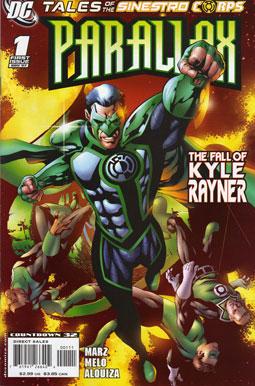 I might have given up early on, except I knew Geoff Johns does great work -- I'd read GREEN LANTERN #16-20, and thought they were among the best comics published in the first half of 2007 (immediately pre-SINESTRO WAR). So I trudged through the beginning issues.
I might have given up early on, except I knew Geoff Johns does great work -- I'd read GREEN LANTERN #16-20, and thought they were among the best comics published in the first half of 2007 (immediately pre-SINESTRO WAR). So I trudged through the beginning issues.At the end, I was glad I'd trudged. Going into the second half, the huge cast began to gel, and the TALES OF THE SINESTRO CORPS one-shots (among other in-story background) provided context I was really needing. The background material the one-shots contain should ideally have been presented earlier, but apparently the tale grew in the telling, and the one-shots weren't added to the story line until after initial issues of Sinestro War had proven popular ( Wiki '08Feb16) .
As far as they go, PARALLAX is a quick read with a simple theme and a tacked-on, kind of sloppy ending -- but it did a lot to fill me in on a character who plays a major role in the main story. CYBORG-SUPERMAN does the same for the Manhunters and the title character, who I knew literally nothing about except that he'd somehow figured into the “Death and Return of Superman”. SUPERMAN-PRIME gives us the character's background from CRISIS ON INFINITE EARTHS.
 The SECRET FILES issue, incidentally, also has plenty of information to fill in blank spots for new readers, but it also contains spoiler info because it's up to date with the end of SINESTRO WAR rather than the beginning.
The SECRET FILES issue, incidentally, also has plenty of information to fill in blank spots for new readers, but it also contains spoiler info because it's up to date with the end of SINESTRO WAR rather than the beginning.SINESTRO WAR was difficult for me to get into, but I don't consider it a flawed story for that -- it's just that I was on the fringes of its target audience. It isn't KINGDOM COME or EARTH X, where a newbie can pick up and appreciate exactly what's going on because the subject matter is a cast of iconic characters in entirely new situations. SINESTRO WAR isn't supposed to be that. Johns, Gibbons, etc. do a fine job scattering background throughout the chapters as a refresher on Sinestro's relationship with Hal, previous GL Corps matters that tie in, and so forth, to the extent they're able in very short flashbacks -- it's just not enough to pick up on the full sweep of events unless one has read the basis material.
I'm sure if the authors had given us a thorough briefing on GL history in a chapter or two at the beginning of SINESTRO WAR, they would've bored hell out of their intended audience of GL fans who've been with the characters a while. Johns, etc. intend SINESTRO WAR as the middle segment in a trilogy that incorporates and expands existing GL mythology. I can't imagine a writer(s) doing something that big and making it newbie-friendly without slowing things down inexcusably.
A second place where SINESTRO WAR at first seemed to be falling down was that up until Part Six, there was no human interest element to speak of. It's a war story and not a character drama, but every good story calls for development of a character or characters or the exploration of a theme, regardless of how much shooting is involved.
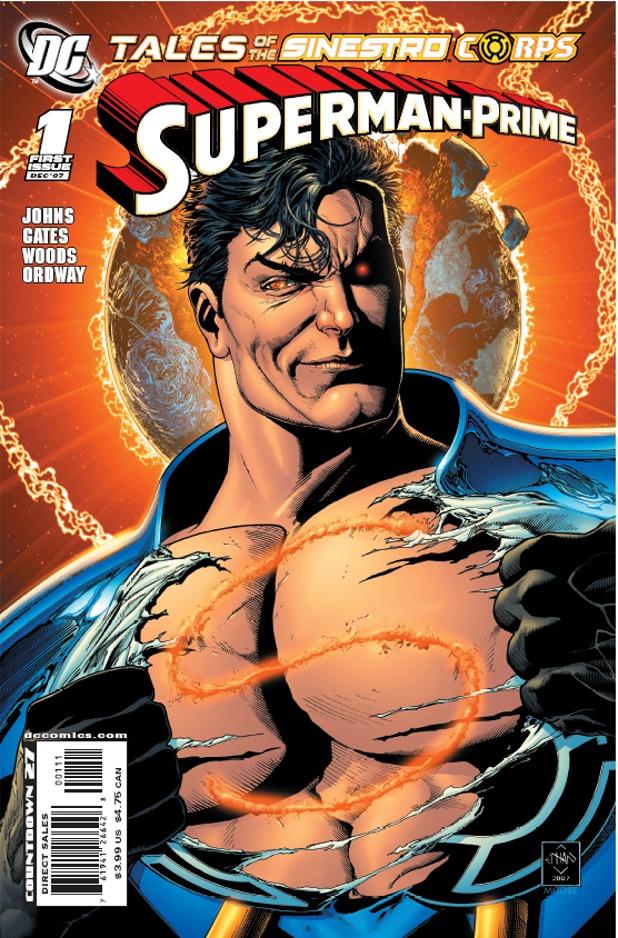 In its first half there's not really much in SINESTRO WAR to care about. It looks like it's shaping up to be SECRET WARS over again -- just a huge superbrawl that'll run on for 11 or 12 issues. It's never SECRET WARS bad, of course -- the characters are well-written even if they don't seem to be going anywhere, the environments are interesting, and the artwork is often stunning. Then, thankfully, the emotional tone abruptly changes and the final half involves us with several of the characters (even, to a lesser degree, with some of the villains).
In its first half there's not really much in SINESTRO WAR to care about. It looks like it's shaping up to be SECRET WARS over again -- just a huge superbrawl that'll run on for 11 or 12 issues. It's never SECRET WARS bad, of course -- the characters are well-written even if they don't seem to be going anywhere, the environments are interesting, and the artwork is often stunning. Then, thankfully, the emotional tone abruptly changes and the final half involves us with several of the characters (even, to a lesser degree, with some of the villains).If the reader is already familiar with GL/DCU history, it may be that none of my previous statements will apply. If the reader already knows these characters and their backgrounds, there might be elements present in the first half that were completely lost on me as a new reader. I won't argue the point -- I know my own ignorance. But I expect that most readers new to GL and/or the DCU, picking this story up for the first time in TPB, will have an experience similar to mine; if that describes you, be warned you could be in for a rocky start with SINESTRO WAR.
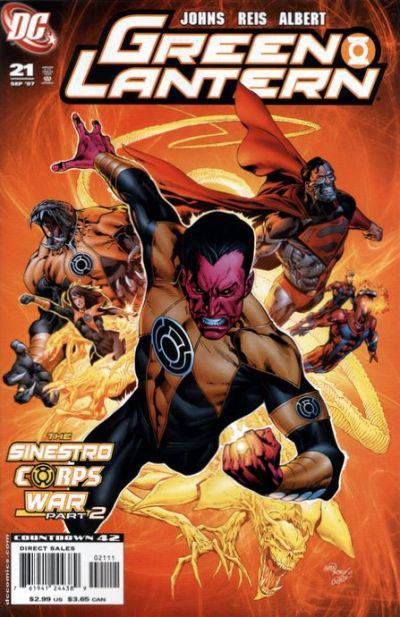 As to what Johns, etc. do that you'll probably like regardless of whether you know the GL/DCU mythology...
As to what Johns, etc. do that you'll probably like regardless of whether you know the GL/DCU mythology...Even as a GL virgin, I can tell a tremendous amount of work has gone into this. What's here is plenty to get me interested in going back and exploring some of the roots of SINESTRO WAR, so even though I found the first half discouraging, the second half has me interested in looking in particular at Johns' prior GL work, as well as some GL history in general.
Johns and Gibbons draw from diverse sources for the war. The creepy kids who can explode, and head straight for the heart of Mogo, are an effective combination of accounts of Vietnam and 9/11. The reprogramming of the rings in the middle of SINESTRO WAR and the resulting question over whether the "good guys" are any better than the "bad guys" when they rewrite the rules with their backs against the wall echoes concerns in the U.S. right now, as in an attempt to adjust to the newly demonstrated domestic terrorism threat we do things we once would've condemned other countries for doing.
Sinestro's feeling that he won, regardless of any superficial goals he had, by provoking the GL Corps onto the slippery slope of abolishing a long-standing bylaw is chillingly in line with the possibility that we in the U.S. have already lost the War on Terrorism. Despite the fact that not a blow has been struck against us domestically in seven years, we've set a precedent for giving up our freedoms in exchange for a feeling of security; Johns appears to be addressing this in metaphor, as the Lanterns sacrifice part of what's made them Lanterns in exchange for the security of the revised bylaw (Johns is already beginning to explore this theme in GREEN LANTERN #26.).
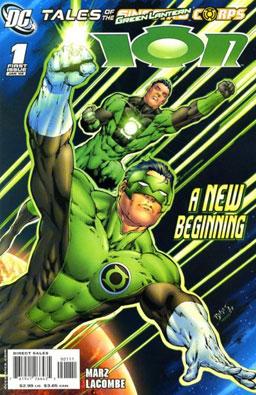 The battle scenes, of course, are 80% of the page count, and they're excellent. They seem to do what the STAR WARS prequels tried and failed to do. They succeed in giving the impression that critical events are happening on more than one or two fronts, rather than just the "generic war background" Lucas seemed often to fall back on. Heck, there's even a Death Star, after a fashion.
The battle scenes, of course, are 80% of the page count, and they're excellent. They seem to do what the STAR WARS prequels tried and failed to do. They succeed in giving the impression that critical events are happening on more than one or two fronts, rather than just the "generic war background" Lucas seemed often to fall back on. Heck, there's even a Death Star, after a fashion.The JLA (and JSA and pretty much everybody) gets involved. I was wondering early on if SINESTRO WAR wasn't big enough that it would be awkward to pretend the GL's were the only superheroes in the DCU, so I was pleased when the other heroes appeared. At the same time, I was glad their involvement wasn't executed as the kind of loathsome sprawling crossover Marvel does.
And a personal peeve SINESTRO WAR avoids: it's not possible for most authors to spend the time to make the vast majority of fictional alien environments feel real. Readers get shortcuts -- "this is an alien world that's basically the wild west; this is an alien world where the only real difference is plant people," etc. This is a necessary evil especially in GL comics. Johns and Gibbons elegantly avoid this pitfall, given the constraints of the format, by offering us alien settings -- but not dwelling any more than necessary on alien civilizations, and then moving everything to Earth for the final half.
Finally, SINESTRO WAR is effectively over with GREEN LANTERN #25. The two Epilogue issues I've read, and the ION one-shot, seem to be little more than DC cashing in on a successful story arc by slapping the SINESTRO WAR title on anything with a tenuous connection.
Each of those issues has moments that shine, but not enough of them to make an issue out of (with the possible exception of GREEN LANTERN #26, which starts moving things forward into new territory again). They're largely an exercise in decompression, presumably to stretch sales. This might be true as well of the “Sinestro Corps War Crimes” material I've started to see, but I haven't looked into it to find out.
 Mid-arc cruft is minimal, but does include the BLUE BEETLE story which could just as easily have been skipped.
Mid-arc cruft is minimal, but does include the BLUE BEETLE story which could just as easily have been skipped.In conclusion, while I'd enjoyed THE SINESTRO CORPS WAR immensely by the time I was done with it, it took me a while to get through the early issues. I can't, without reservations, recommend it purely on its own merits -- the reader should either be already familiar with the material SINESTRO WAR builds upon, or be willing to experience some confusion and disorientation in the first half of the story. That aside, this arc will clearly become a mainstream comics classic, and I have little doubt it will soon be numbered among the most important Green Lantern stories.
Edward Livingston-Blade is barking frog and thinks a Power ring would be really great for scratching that spot you can't reach right in the middle of your back. When he's not doing reviews Edward is the writer behind the genre-defying comics/prose multimedia project The Man Who Wasn't There -- regular new installments of which will begin appearing Real Soon Now.
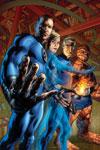
FANTASTIC FOUR #554
Writer: Mark Millar Penciler: Bryan Hitch Publisher: Marvel Comics Reviewed by Humphrey Lee
Out of the recent wave of new and upcoming Mark Millar projects, this beginning of his FANTASTIC FOUR run is easily the one I figured I'd probably end up giving a shot to. Really, I'm not out to try and overly criticize the man because there are a solid amount of titles and runs he has come up with that I have enjoyed a good bit, but there's also a lot that have come off as too self-indulgent for their own good, or in some cases downright egotistical (I'm looking at you WANTED #6). When the man is channeling his creativity to the max, though, and can keep these tendencies in check, those are when he really earns all the praise he garners. His ULTIMATE FANTASTIC FOUR run immediately comes to mind, and I figured if he could handle those characters about as perfect as you get, then it shouldn't be much effort to come up with a years’ worth of adventures for their older, more "mature" (with one notable exception) 616 counterparts.And what do you know, it’s looking like it worked out...
I didn't have this on my pull sheet. Like I said earlier, I tend to have reservations about Millar books at first, but all it took was the first couple pages with a time-jumping Richards family crashing in on the present day after being chased down by Indians (shooting bullets with their bows, apparently, but I'll forgive this little mishap cause it looked pretty) and Johnny Storm stepping in just in time to make fun of Ben's specialty garb and then proclaiming he's off to become a rockstar. Just another day at Four Freedoms Plaza.
The rest plays out more as setup than anything, or playing more a "Day in the Life" of the team with Ben and Reed off to Ben's old school to entertain for the day, Sue playing philanthropist and getting a group together dedicated to helping people victimized by superhuman incidents, and Johnny off to be, well, Johnny. It's really more of what make the FF such an enjoyable group to read about when they're handled properly. That sense of family and day-to-day tribulations that come with it really help humanize these superpowered individuals, and the entertainment factor is exacerbated by being the most famous family on the planet and all the "joys" that come with that fact. Millar definitely knows how to play this all up which made this one of those books where you're constantly smiling to yourself as you read it. Top it all off with a pretty unexpected and intriguingly futurist cliffhanger and I can say this should be a great year for the First Family.
On art, well, you should know what to expect with Bryan Hitch pencils by now. Ultra-detailed, very realistically rendered, with just a hint of photo-referencing (which in this case doesn't seem to be terribly apparent). Most of the issue takes place in standard Widescreen panels, but that's how Hitch gets his flow on so it works very well for his style of pacing. And did I mention detailed? There might not be a lot of action in this particular issue, but I'll be damned if every panel isn't crammed with as many nooks and crannies and knicknacks as you can find making it look like, y'know, a real household. Add in the two page splash at the end of the book and you can check off the art as being on its game too. Amazing what a little lead-in time can do...
I'm always a big fan of FANTASTIC FOUR being a "must read" book. Really, given the lush creative history of the title, and just the essence of who and what they are, and combine all that with the fact that they've never really been terribly overexposed even with a couple semi-hit movies the past few years, there's just really no excuse to not be able to give a creative team some free reign with the book like Millar and Hitch are doing here. It's been at least since Waid and the late great Mike Wieringo were doing their thing on the title that I've seen anyone doing what is going on in just one issue of this team here, and that's really kind of a shame. But it looks like the book is back in good hands, even if it's just for a fleeting run. The way the things are going in this age of comics, you learn to take what you can get.
Cheers...
Humphrey Lee is a long time AICN reviewer and also a certified drunk whose claim to fame is making it up four steps of the twelve step program before vomiting on steps five and six and then falling asleep on steps one through three. Also, chances are, he's banged your mom (depending on the relative hotness of said parental figure) and is probably the father of one of your younger siblings.
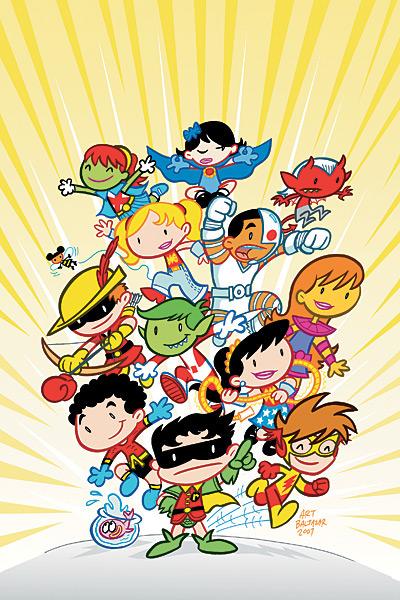
TINY TITANS #1
Words by Art Baltazar & Franco Art by Art Baltazar Published by DC Reviewed by Tiny Stones Throw
Sometimes the customary @$$hole reviewing techniques aren’t suitable for every book. I took a second look at my 1,000 word thesis on DC’s TINY TITANS # 1, a new production by the graphic novelists Art Baltazar and Franco, with detailed analysis on significant panels like the one on page ten where the Tiny Titans throw their arms in the air and yell “YYEEEAAAYYYY!!!” (the way Aqua Lad and Beast Boy’s arms partially protrude from the four, prison-like walls of the rectangle and into the white void of the page gutter, combined with the unorthodox spelling of “yyeeeaaayyyy”, being highly representative of a youthful exuberance according to my interpretation), and decided another voice, more in tune with the publication’s target audience, was needed. I opted to consult my inner child, whom a few gallons of Bushmills’ was enough to bring out.So, Tiny Throw, what did you think of DC’s most recent stab at kids’ comics?
Okay people, first I want to say that this comic book was totally GAY! Like, first of all, no one died in it! Twenty too pages, not one death! I mean, I get PREACHER and CONSTANTINE from the libary, lots of people die! I read CIVILL WAR, Black Goliath got shot thru the chest with a lightning bolt by clone Thor! THAT was realistic!
This won, no deaths! Just mischievous kid versions of the Teen Titans in hilarius and cute punch lines like the Sunday funny papers! And by the way, who the gosh darn frickin’ hell cares about the Teen Titans?!! The X-Men are much cooler, they don’t have the word “teen” in the title. And some off them carry weapuns.
And also, the way they printed the comic on non-shiny paper so it would cost less was, like, the worst thing ever!! Like kids wouldn’t notice that! I mean, this is the kind of comic book that might actually get kids to start reading comics, or start reading altogether! That sucks!!! Reading is GAY! And it appeals to GIRLS equally to boys! I mean, like, 3 WHOLE PAGES of Starfire, Batgirl, Wonder Girl, Raven and Bumblebee walking along with lollipops making jokes! Ick!! And none of them even had to bend over in the foreground!! OncE!
I mean, most comics I read, the stories drag out for months across issues. This one, lots of stories in one book! What the hell were they thinking?!? Where was the characterization?! I don’t feel like I know who Kid Flash IS!!! And what about continuity? In Robin’s own title he bit Ra’s Al Ghul’s ear off! Where was the ear here? I didn’t see it! And I haven’t even mentioned that this book completely IGNORES COUNTDOWN TO FINALL CRISIS!! WTf?! Is it just miraculously existing on its own? I say the way editors are slacking off their jobs has gone far enough!
To sum up, this is a comic aimed at kids and totally on our level. That SUCKS! No bawdy jokes for adults, just refreshingly clean, juvenile humor!! That SUCKS! The art is gorgeously cartoony and simple to understand! That SUCKS! Should have got Jim Lee, gaylords! Rather than stretching out one dull storyline across multiple issues, this book contained dozens of gags and stories in just one comic! That SUCKS! This was like a comic back from when kids actaully RED comics! Quit living in the past, DC!!!
Finaly, the puzzle to help Beast Boy find his puppy was, like, WAY too easy. It took me thirty seconds! The trick is to trace backwards.

THE NEW AVENGERS #36
Writer: Brian Michael Bendis Artist: Michael Gaydos Publisher: Marvel Comics Reviewer: Jinxo
People, THIS is how you break up a super hero relationship. Mephisto-shmisto. This is the evil heartbreak of a true split. Awesome. Just a true kick in the scrotum for poor Power Man. And in a way it’s a return to the Jessica Jones from ALIAS. Back then she was well intentioned but so messed up and self-destructive. Of late she’s fallen to the background and become just the “mom” character, “Luke Cage’s wife”. The issue starts where the NEW AVENGERS ANNUAL left off: having barely pulled herself and her baby to safety after an attack on Doctor Strange’s house, Jessica Jones flees with her baby to Stark Tower seeking asylum and wanting to register with The Initiative. This issue covers the ugly fallout. It’s good stuff.Now, I’ve stated all of the above as if this was just a normal situation but of course this is actually playing out over the backdrop of the Skrulls’ Secret Invasion. It adds another level to things. Quite frankly, it seems pretty clear here who the Skrulls used as a mole inside The New Avengers. The thing I like is that you can see it clearly by reading between the lines. The New Avengers are sort of a problem as far as infiltration. They’re unregistered. Hard to learn their history to seamlessly replace them. And they’re hiding out, so hard to slip a substitution into their ranks. Now the Skrulls could have made their move before the Civil War, but that’s still problematic. The team split in two different Avengers groups. 50% chance any spy might have went to The Mighty Avengers. But it is clear there is someone in the gang who exited the book and then returned. But then, of course, the group is now alerted to the Skrulls. They’re on the lookout for infiltrators. Harder for a Skrull to con folks. Might call for a change in tactics, maybe shift from infiltrating to putting the heat on our guys. They’re already distracted, distrusting of each other. Just need to take up a position where you can put pressure on them and keep them on the defensive and they won’t be a problem.
What would normally disappoint me is that the clues are there for The New Avengers to piece it together. But here I buy that they really wouldn’t. Jessica’s defection is too distracting. In particular, it has Luke Cage so in pain that he’s not thinking clearly. I like that a whole lot. Usually when a leading character misses something they should see the writer doesn’t take the trouble to come up with a plausible reason for it. It’s like, “They need to be dumb for things to work so they’re dumb.” Here Bendis supplies a giant, distracting, thoroughly entertaining load of pain as a believable distraction.
In terms of the art I also love seeing Michael Gaydos drawing this issue. I just have not been able to get behind the art on the book of late. Might be some people’s cup o’ tea but it was bugging me. Actually Gaydos’ style is just vaguely similar enough to Yu’s recent work on the book that it makes for a nice transition. Seeing as Gaydos was there at the start of Cage and Jones’ relationship in ALIAS, it seems appropriate for him to be there for the end. It also gives readers a little more context to appreciate any emotion – or lack of emotion – Luke or Jessica display. He’s drawn these characters’ emotions before. When he brings the pain, he knows how it should look. We know how their reactions as drawn by him should look. Or not.
Plus the Avengers go apartment hunting. Dammit. I just know they’ll be upstairs from me. “Hey, dickweeds! I’m trying to watch TORCHWOOD down here! Could you keep your alien battles to BEFORE 8pm? Thanks a lot.”
Jinxo is Thom Holbrook, lifelong comic book reader, and the evil genius behind poobala.com. He may appear cute and cuddly but if encounter avoid eye contact and DO NOT attempt to feed.

BOOSTER GOLD #0
Writer: Geoff Johns & Jeff Katz Artist: Dan Jurgens & Norm Rapmund Publisher: DC Reviewer: Optimous Douche
To truly appreciate the zero issue of BOOSTER GOLD – The Greatest Hero the World Has Never Known, you will need to open up your own brain pan, scoop out the messy gray matter that allows you to process the words on the pages of Ain’t It Cool News, and plop in the portion of Geoff Johns’ brain that holds his unwavering reverence for DC material that is almost a generation old.Like his turn on Green Lantern and the other countless DC books Johns is currently scribing, the characterization in this book harkens back to an earlier DC universe. Forget the first Crisis, certainly forego the Second Crisis and its slew of ancillary titles, keep a smidge of Zero Hour knowledge on hand and take a trip back to 1987 when DC first rebooted JUSTICE LEAGUE.
In my humble opinion, this is the last time that DC characters had true personality. I’m not talking about the staple personality traits like Batman being eternally morose or Superman’s corn fed “awww shucks” attitude on everything from global cataclysm to his first hummer from Lois Lane. When I say personality, I’m talking about the personality of the ancillary characters. I want you to take a second and think of your favorite movie, television show or play. Think about what you remember most from the show. The truly memorable characters are not those at the forefront driving the action, but rather it’s the minor players with their delicious off-center idiosyncrasies that make the action or the plot more enjoyable. In the show “Silver Spoons”, was it Ricky Schroeder’s pampered little rich boy that made the show funny or was it Jason Bateman’s sarcasm laced dialogue that kept the show going?
When I picked up the first issue of JUSTICE LEAGUE in 1987, I was traversing unknown territory. Up until that time I had wasted my youth burying myself in RICHIE RICH and the billions of titles that told the tales of his pampered exploits. I made a few forays into the darker side of comics, but never fully committed myself to action oriented titles. JUSTICE LEAGUE accomplished what Batman and Superman were unable to do: Giffen wrote a cast of characters that were not only hell bent on saving the universe, but had a good time doing it as well. You truly got to know the characters as people, not just as superheroes. From the exploits of slutty Fire trying to corrupt Ice’s virginal outlook on life, to Guy Gardner trying to coerce Fire and Ice into a Green Lantern sandwich, Giffen wrote a title with as much humanity as it had action. Rounding out this team of super heroes were Booster Gold and Blue Beetle serving as the Rosencrantz and Guildenstern of their age. Their comedic outlook on every situation, no matter how dire, was what kept me collecting every issue of this title until I went to college and started spending my “fuck you” money on beer, bongs and babes.
When I got back into comics after my eight years in undergrad I was crestfallen to see that these two characters were not only no longer with the Justice League, but had fallen into relative obscurity in the entire DC universe. Flash forward a few more years to see my heart cover with ice when Maxwell Lord held a gun to Blue Beetle’s head and splattered his comedic mind all over the floor of Checkmate’s headquarters.
Well all I can say is, “Thank God for time travel.”
Thanks to the incongruity of this H.G. Wells inspired plot device, my favorite comic book comedy team is back in action with the help of the first Blue Beetle, the current teeny bopper Blue Beetle and the Blue Beetle from the 27th century.
I’ll admit right now, having shunned anything “Crisis” after 52 I was at a bit of a loss when I first started reading this title. I understood Booster Gold’s motives for trying to save his life long hetero partner and why the other Blue Beetles are along for the ride, but how Booster was charged with protecting the time stream escaped me. But you know what, I don’t care. I still enjoyed this book.
I enjoyed it for every reason I loved the JUSTICE LEAGUE twenty years ago. Johns gets these characters. He gets their friendship and he gets the fact that these two would probably be bitching with biting whit in the Talkbacks if they had never been blessed with super abilities. He doesn’t try to mire the title in explaining time travel. There are no Doc Brown Flux Capacitors, no Star Trek inspired slingshots around the sun; there’s a time bubble manned by Booster and that time bubble is used to bring Ted Kord, the second Blue Beetle, back from his eternal dirt nap. There’s one point in the book where the current Blue Beetle is trying to rationalize a particularly nasty encounter they just had in the time stream with the Hal Jordan version of Parallax and Extant, which chronologically speaking was actually settled way back during Zero Hour, when the first Blue Beetle simply states, “Time travel Jaime, it’s best left alone.” Flip, carefree and utterly unforgiving in mockery and childish antics is the true heart of this title and Johns delivers on every damn page.
The art gets the Optimous Douche rating of “meh”. It’s neither stellar, nor awful. I’m going to use yet another review to harp on the importance of backgrounds. The time stream was blue. If this book is going to have legs as an ongoing title, the time stream will be just as much of a character as Booster and Beetle, so make it something more interesting than…blue. Also, everything in the 25th century aside from Gotham City’s skyline looks the same as in this century. I have to believe lockers 400 years from now will look better than the ones I was stuffed in during high school.
This book can go places; I see it being DC’s version of EXILES when that book was new (now that it’s safe to say EXILES officially sucks). These two can traverse the time stream from the Golden Age to the far distant future and reap the benefits from almost 100 years worth of storylines in their mission to set the time stream straight.
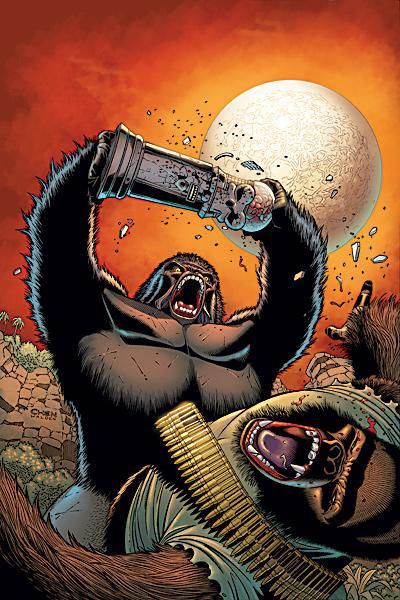
SALVATION RUN #4
Writer: Matthew Sturges Penciller: Sean Chen Publisher: DC Comics
PUNISHER WAR JOURNAL #16
Writer: Matt Fraction Artist: Howard Chaykin Publisher: Marvel Comics Reviewer: Sleazy G
I don’t normally compare and contrast two issues so directly in my reviews, as I prefer to focus on the positives or negatives of an issue without muddying the waters too much. In this case, though, these two issues share such similar themes and characters it makes sense to pair them up. Unlike in the fight that is the centerpiece of SALVATION RUN, however, I think there’s a pretty clear winner in this throwdown.First, though, why the comparison? Well, here’s the thing: both of these issues focus on has-been primate-based villains trying to step up and rehabilitate their reputations. They choose different paths to do so, with considerably different results. In the case of WAR JOURNAL the results feel inevitable, logical, and a bit depressing. In the case of SALVATION RUN the results feel unnecessary, ill-considered and annoying as hell.
I’ve read all of Matthew Sturges’ work at DC thus far, and he’s been doing a job that ranges from solid if a little dull (SHADOWPACT) to highly entertaining (JACK OF FABLES). He stepped in to take over SALVATION RUN with issue #3 when Bill Willingham had to step aside, so I don’t know how much of the story is Sturges working from Willingham’s plot and how much is original work. Since Sturges works so closely with Willingham so often, though, I suspect the events of this issue were Willingham’s idea. This is fortunate for Sturges, as it somewhat deflects the blame for my reaction, which ranges from disappointment to disgust.
Look away now, folks, if you don’t want me to ruin the outcome of this issue for ya: on the alien world of SALVATION RUN, there’s no Gorilla City, so we’re headed straight for SPOILER CITY. Spoilery spoiling ahead, so turn back now if you’re too afraid of the savage yet brilliant spoilers that inhabit this great capital of spoiler society.
The centerpiece of this issue is a battle between Gorilla Grodd on the one hand and Monsieur Mallah and the Brain on the other. And don’t get me wrong, it’s a real slobberknocker of a battle. Two big, angry gorillas beating the holy hell outta each other is good comics, and Sturges does a good job with characterization throughout the issue. But by the end of the battle, Grodd has beaten Mallah to death with Brain’s containment unit, leaving the two dead in each others’ arms. Well, Brain hasn’t got arms cuz he’s a brain, but…y’know.
And then, just five panels later, Grodd—whom Mallah shot several times point blank in the chest—is kicked off a cliff (presumably, but not definitively, to his death) by the Joker.
No. Just no. Look, This isn’t CRISIS or CIVIL WAR or anything. Ten years from now, nobody’s going to be looking back at SALVATION RUN as a seminal moment in comics history. I understand the book needs a villainous body count, but it seems to me it should probably have been some of the bland, faceless, unimportant villains nobody gives a shit about. Let’s face it—the DCU wouldn’t be any worse off if the frikkin’ Body Doubles bit it. Hell, it’d probably be an improvement. There are some others on the planet that could stand to go, too, to be honest. But Grodd is frankly too important a character in too many characters’ mythologies to go in such a dismissive and pointless manner. Maybe he’ll be back, maybe he won’t, but this was a lousy way to handle things.
Far worse in my estimation, however, is the treatment of Mallah and The Brain. We’re talking here about a couple of the most offbeat, unique, fun characters in the DCU: a talking ape who runs around like he’s in the French Foreign Legion (the inspiration for Van Damme’s “Lionheart”, I believe) and happens to be in love with a guy’s disembodied brain in a jar? That’s the kind of batshit creative fun that comics need more of, not less, and to have them punked out like this is just another waste of characters who had far more potential alive than they got the chance to exercise in a pointless death in one of a dozen miniseries tied to a three-year event. I appreciate Sturges’ desire to give them a poetic, touching exit, but frankly it occurs over too few panels to have much impact, and it was a bad decision all around. The DCU just got a little less interesting and a little less fun, and it bums me out to no end.
 But on to the good: PUNISHER WAR JOURNAL. It’s a done-in-one story that pauses to follow up on recent events in the title. A while back, Frank Castle blew up a whole bar full of third-rate Marvel costumed villains just to let them know he hadn’t forgotten about them while he was busy MAX’ing it up. There was no way they could all be dead, but it did leave one wondering just what condition they were left in, and we get a look at the aftermath here. It follows The Gibbon around, and it turns out things aren’t going so well for him: his wife Princess Python is now blind and harangues him constantly, he no longer looks like a primate (and instead just looks like a meathead who got his face worked on with a pipe), and he’s attending survivors’ meetings for all the battered villains who were in the bar that day.
But on to the good: PUNISHER WAR JOURNAL. It’s a done-in-one story that pauses to follow up on recent events in the title. A while back, Frank Castle blew up a whole bar full of third-rate Marvel costumed villains just to let them know he hadn’t forgotten about them while he was busy MAX’ing it up. There was no way they could all be dead, but it did leave one wondering just what condition they were left in, and we get a look at the aftermath here. It follows The Gibbon around, and it turns out things aren’t going so well for him: his wife Princess Python is now blind and harangues him constantly, he no longer looks like a primate (and instead just looks like a meathead who got his face worked on with a pipe), and he’s attending survivors’ meetings for all the battered villains who were in the bar that day.The Gibbon’s life sucks, and he knows it. He’s a miserable sad sack, and he sees only one way out: get a gun and go after Frank Castle for some payback. So in between meetings and replacing his wife’s dead snake without telling her, he goes through the process of secretly getting false papers so he can buy a gun legally (he’s surprised to find nobody involved questions him or cares). But something else happens: this depressed mope sees a lousy pimp who’s always beating on his girls, because the Gibbon has to pass them on the street every day, and he starts to really hate the guy. We see this poor, downtrodden failure of a man, and we see him start to care about somebody else’s problems, and we see him start to see things the way Frank Castle does. The Gibbon comes to realize some people are bastards who prey on the helpless, and he starts to work up the nerve to go all Travis Bickle on this asshole pimp.
And then The Punisher appears from out of nowhere and ices the pimp just before The Gibbon works up the nerve. Poor guy is close enough to get spattered, but didn’t get a chance to follow through. And now he finally has the shot he wanted at Castle, and he can’t take it. He actually gives the gun to the Punisher and slinks back home to give his wife her snake. This might have been the opportunity to show him feeling just a little bit better about himself, or give a wry smile of acceptance, or laugh at the coincidence of it, but no: Fraction makes the decision to have The Gibbon end up even more beaten than he was before the confrontation, a pathetic wreck with no one he can share his pain with.
This, folks, is how you take a low-level, primate-based villain and make people care about them. By the end of this issue I found myself relating to The Gibbon, a character I hadn’t thought twice about in…well, ever. Fraction built him up, gave him a little back story, and left the character far more appealing than he found him. It’s good writing, good for the characters involved, and good for the Marvel Universe. Which is why, although I have to admit SALVATION RUN #4 was well written, I feel it was ultimately misguided and inferior to PUNISHER WAR JOURNAL #16: one took the opportunity to build a character up in a way that strengthens him and the story around him, while the other took appealing, interesting characters and brought them to a sudden, pointless end that belies their potential.

NOVA ANNUAL #1
Writer: Dan Abnett & Andy Laning Artists: Mahmud A. Asrar, Klebs & Wellington Alves Inkers: Juan Vlasco & Nelson Pereira Publisher: Marvel Comics Reviewer: Rock-Me Amodeo
Blue blazes! There’s one bittersweet trademark of a good comic book, and this annual fulfills it. I’ll remind you what it is at the end of the review.I really liked NOVA when it came out the first time. John Buscema, the artist back then, brought instant credibility to any comic book, and NOVA was no different. But it was more than that – I liked the character, the concepts, the supporting cast. By the time Carmine Infantino was penciling the last few issues (an omen which never boded well—see: MS. MARVEL v1) I was wondering where things had gone wrong. I wondered…well, that’s all the past. And this is a whole new book, one that Abnett and Lanning have made their own. The only thing that made me think of it was the innocent way that we used to accept phrases like “Sweet Christmas!” “Suffering Sappho!” And, of course, “Blue Blazes!” That was then.
This book is now. And then. And sometime in the future. It managed to take Nova’s story back to his humble beginnings and add a few twists. Then it took the story to the future and added a few more twists. What seemed like a recap of the last episode of “Star Trek: Next Generation” became something much different. And the nice thing is, this issue is both a continuation of the existing story line AND a great jumping on point for any new readers.
This incarnation of NOVA has not suffered for a lack of excellent artists, and we have three good-to-excellent artists here. Mahmud Asrar handled the segments set in the past, and that first page was so old school, I almost giggled with glee. And does anyone remember this “Ginger” character? I want to see her again.
Wellington Alves took the sections set in the future. Alves knows what he’s doing, and for some sections that didn’t have much action, he still managed to convey a sense of urgency (helped along by strong writing, especially if you have followed the story the last few months).
Klebs Demoura bats cleanup, but if I hadn’t already been vested in the story, I think I would have been disappointed. It’s like bases loaded, Klebs on third, and the game is tied. Then the batter walks. Klebs scored the game-winning point, but not in dramatic fashion. Not much in the way of backgrounds, just a boy and his bad guy. It wasn’t bad, but it wasn’t compelling. Still, I’ll be interested to see how much he improves in a year or two.
The writing was excellent throughout, and paints an interesting distinction between the Nova Corps and the Lantern Corps of the Distinguished Competition. I won’t spoil it, but lets just say that I could never be a Lantern, but I might could be a Nova (no, it’s not just for geeks).
By the end of the book, I couldn’t wait to see what was going to happen next. I wondered why the origin had changed. I wondered how the heroes were going to overcome the final threat. And then I wondered how in the world (Earth? Kvch?) this was going to end.
And when we got to that end, I couldn’t believe it was already over. And THAT is the hallmark of a good book. Thirty-seven or so pages was WAY too short. Blue Blazes!
Dante “Rock-Me” Amodeo has been reading comics for thirty-five years. His first novel, “Saban and The Ancient” (an espionage/paranormal thriller) was published 2006. He began writing for AICN Comics in 2007 and his second novel (“Saban Betrayed”) is due 2008. He’s often told he has a great face for radio.
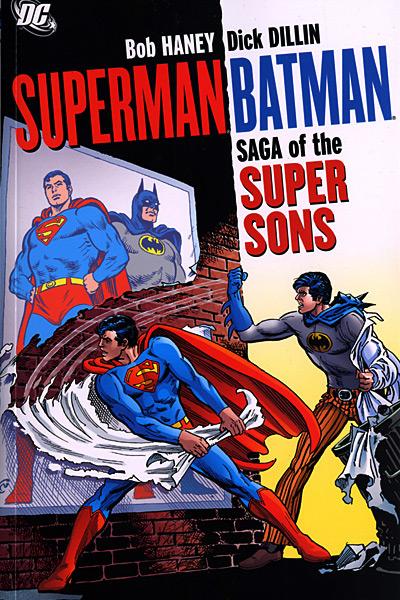
SUPERMAN/BATMAN: SAGA OF THE SUPER SONS TPB
Written by Bob Haney Art by Dick Dillin and others Published by DC Reviewed by Stones Throw
“I can’t believe they’re our fathers—they’re both so young and right on--!” – Bruce Wayne, Jr., WORLD’S FINEST #215Since Superman and Batman both have kids in their titles at the moment, DC has seen fit to reprint these mid-1970s issues of WORLD’S FINEST where the Kid of Steel and the young Dark Knight Detective team up to get away from their over-bearing dads. Of course, Superman’s son in the current continuity is actually the offspring of exiled Kryptonians General Zod and Ursa from their period of captivity in the Phantom Zone (gives a new meaning to “kneel before Zod!”, I suppose) and Batman’s sprog is from a long out-of-continuity Mike W. Barr story in which he slept with Ra’s Al Ghul’s daughter Talia, but in these issues they’re the real deal: there’s no explanation that this is set in a parallel universe or if it’s an imaginary story (well, as Alan Moore said, all comic books are imaginary stories) and Superman and Bats are both seem to be their usual ages, so we’re left to consider the possibility that Superman and Batman secretly did have kids. The fact that their wives’ faces are, like Ray Winstone’s schlong in BEOWULF, never seen, raises the disturbing yet hilarious idea that the two heroes were keeping women on the side while swinging with Lois Lane and Vicki Vale.
The basic structure these adventures take is Superman Jr. and Batman Jr. journeying around together and coming across suspicious ghost towns or crimes that need solving. The hilarious thing about this is that it’s all set against a mid-70s DC Comics idea of youth culture, which wasn’t quite as progressive as the dope-smoking Marvel of the day. The Super Sons are rebelling against their dads because of “the generation gap” (like, “But the generation gap’s still there! You weren’t straight with us! We’re off to find some laughs! See ya, super-dads!”, or, “Man, I’m down with the same old problem…generation gap, super-style!”). However, I have to credit the book with a somewhat realistic depiction of teenagers. For example, in the first story in this collection, the Super Sons are annoyed that their dads won’t let them do any costumed crime fighting, so as a test run Superman dives into the ocean and shakes the San Andreas fault, using the ripple effect to create a temporary, duplicate Sparta City so the kids can have a go at taking down its main mobster Rocco Krugge. Naturally, the kids fuck up and are captured by Krugge’s men. Okay, when I said “somewhat” realistic, I meant “not at all”.
Some continuity gaffes were spotted: in the first story, Batman Jr. tells us that he only recently found out there was more to his dad than Bruce Wayne the shallow playboy, but later on in flashbacks we see Bruce returning home in costume when Bruce Jr. is a little kid. Either Li’l Batman thinks his pop has some weird sexual preferences or something’s kind of screwy. Actually, something’s kind of screwy both ways. I also dug Batman telling his son that to take down criminals “you must have evidence! You can’t play vigilante!”
The dynamic is one that works, though. Hipster “Bruce the lover” Batman Jr. and the slightly less headstrong Clark Kent Jr. contrasted with their reserved, conservative dads. There was one story I particularly liked where the four of them go to the new age therapy retreat ENOYREVE in order to sort out their relationship and are subjected to modern counseling methods like primal scream therapy. Clark Kent Sr. is hesitant to cut loose, and when encouraged to, sends a tree flying. Then, the image of Bruce and Clark being forced to dance with their swingin’ sons (“some of the world’s most masculine men dance together in joy and comradeship! DANCE!”) is just too funny. Naturally, an escaped android, BIO-X7, also happens to be staying at the retreat and fathers and sons are forced to put their differences behind them to bring him in.
It should be said that as stupid as some of these stories are, the stupidest one collected here is from 1980 and written by Denny O’Neill, which cleared up continuity by revealing that the Super Sons were computer simulations in the Fortress of Solitude. Dig the final panel of Superman and Batman sharing a tear after their sons are forced to return to the computer program because they were altering the nature of reality. Yet Bob Haney brought the Super Sons back in 1999’s ELSEWORLDS 80-PAGE GIANT, which had some great art from Kieron Dwyer and dealt with Superman Jr. having to step into his father’s shoes after the apparent death of Superman. I don’t want to venture too far into SPOILER territory, but his last words were “another few million miles and these atomic and hydrogen missiles will be detonated harmlessly…”

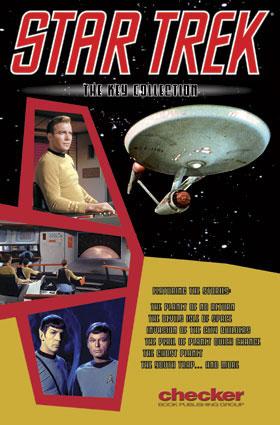
STAR TREK: THE KEY COLLECTION
Writers: Golden Press Staff Artists: Nevio Zaccara, Alberto Giolitti Publisher: Checker Book Publishing Group Reviewer: Prof. Challenger
“Howling Comets! We’ve run smack into a huge electronic field that shields the entire planet! It’s…trapped us, Mr. Spock!” - Capt. James KirkThis is quite the entertaining oddity. Remember the days when Kirk would exclaim things like “Suffering Hannah!” and “Gr-great Novas!” Remember when Scotty was blonde? Remember when the uniform colors were only green and blue? Remember when the nacelles of the Enterprise would blast fire as the spaceship cruised inside atmosphere of strange planets?
What? You say you don’t remember those things? Then it’s time for you to pick up STAR TREK: THE KEY COLLECTION from Checker Books. I’ve talked about Checker here before because they serve a nice role as the reprint home for the forgotten classics and oddities of comics history. For an example of more recent offerings, they are currently reprinting a number of series from the blip in history known as CrossGen and the ALIEN LEGION series from Marvel’s Epic line. This STAR TREK volume is part of an ongoing series devoted to reprinting the entire Gold Key Comics run of STAR TREK which was the Trekkie’s only comic outlet for Trek during the years between the original series and the movie.
It should come as no surprise to anyone that these 8 stories, published between 1967 and 1969, are full of continuity and characterization errors – especially if you have long buried memories of reading and re-reading these things during your childhood. What may come as a surprise is that if you disregard those continuity snafus, these turn out to be fairly solid old-school sci-fi adventures with some decent, and sometimes really excellent, artwork. Although, other than when the artists were tracing publicity photos of the lead actors, only Dr. McCoy and Mr. Spock are the only characters who actually resemble themselves.
The package that Checker has put together is a nice design liberally padded out with photos of the cast and, thankfully, the covers for each issue (along with the date). Now I know what the cover looked like on issue 8 that I owned coverless for most of my childhood. I definitely recommend it for those who enjoy these bizarre gems from the history of comics. And hey! With IDW going strong with their new STAR TREK stuff and the new movie coming up next year (bumped from Dec. dammit!), then this collection is the perfect compliment to those for the Trek comic fan. My only complaint is that I think it’s a bit pricey at $22.95. A reprint collection like this should run more in the $12.95-$15.95 range to better attract the impulse buyer.
Prof. Challenger is illustrator and "Renaissance Man" Keith Howell who is married with two kids, a dog and a cat. Headquartered in the Republic of Texas, he has a glorious ability to annoy people, the strength of ten men, and sometimes updates his website at profchallenger.com.
GRAPHICS CLASSICS: FREE COMIC BOOK DAY EDITION (PREVIEW)
Publisher: Graphic Classics Reviewer: Squashua
As most of you know by now, I'm a huge proponent of giving comic books away to kids, but most of the books on Free Comic Book Day (FCBD) are either too short or the simplest of advertisements with minimal content, so it surprises me when a book bucks the trend, which is precisely what the FCBD edition of Graphic Classics has done.Graphic Classics normally delivers trade paperbacks of their content; there are no single issues, so for them to jump into the Free Comic Book Day scene is surprising to say the least. What's even more surprising is that the book is 62 pages of content. 62 pages of FREE content. That's almost ridiculous, but considering they're republishing classic tales in comic book form, it's not like they had to write or color any of the content (it's black and white like all the rest of their trades).
So how does 62 pages pan out? Very well in fact, and I'll hit each story as we go.
The Black Cat Author: Edgar Allen Poe Adapted by: Rod Lott Artist: Gerry Alanguilan I've never read this one before, but I guess Poe really likes to re-use the "murder a person and hide the body" concept. The artist is quite heavy with his cross-hatching, keeping the world quite dark for this horror story, and unlike some of the prior classics, words are removed from some sections allowing the imagery to tell the short tale.
Diagnosis Author: Ambrose Bierce Artist: Mark Dancey A single-page, 9-panel fable, “Diagnosis” relates an encounter between a monkey and an oyster. It's short, sweet and cleanly drawn.
John Barrington Cowles Author: Arthur Conan Doyle Adapted by: Alex Burrows Artist: Simon Gane “John Barrington Cowles” surprised the heck out of me, turning the story of a love affair into a tale of a vicious woman infected with an insidious and influential evil. This powerful tale of mystic terror entertained me the most. Though somewhat cartoonish, the art style evokes both the sinister and sensual emotions inherent here, additionally handling the Victorian setting with appropriate care. This story straddles the edge of appropriateness when considering FCBD should be focused towards younger readers, but there's nothing here that would create any actual controversy. My favorite story of the volume.
The Dream Author: Mary Shelley Adapted by: Antonella Caputo Artist: Anne Timmons A romance story in the vein of the gothic scribed by Jane Austen, “The Dream” relates a tale of forbidden love set during the reign of Henry IV of France. It's sappy and straightforward, but its appearance here helps to stress the different offerings by the publisher, so the inclusion is understandable. The art is quite detailed, but everyone has bright circular happy eyes that lead to vapid expressions. This story would appeal to the woman in you.
A Narrow Escape Author: Lord Dunsany Adapted by / Artist: Milton Knight An extremely short story of a wizard who wants to bring damnation down upon his already damned city. Knight brings a very silly art style to accompany and compliment this simultaneously serious and humorous stale.
Summary: In all, this book is an excellent example of the variety that Graphic Classics has to offer, and since it's available for free, I highly recommend you don't pass it up, but let the kids have first crack at the stack for Free Comic Book Day.
